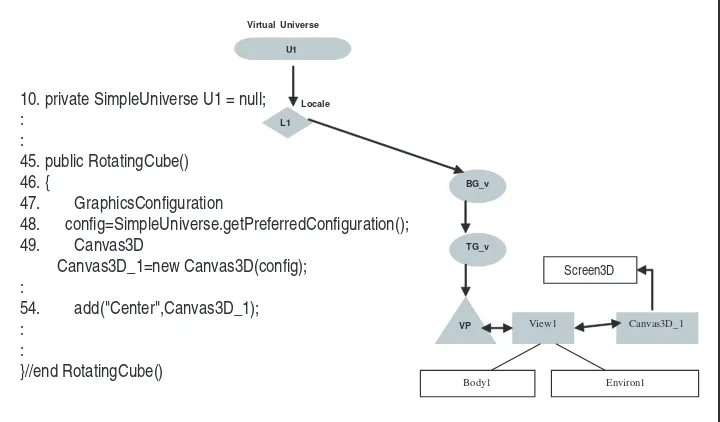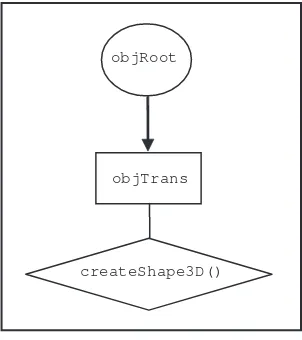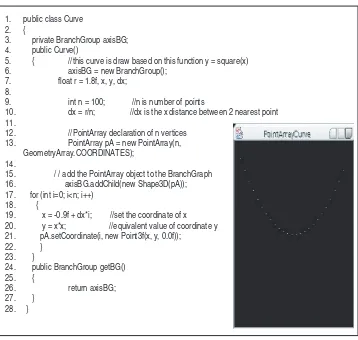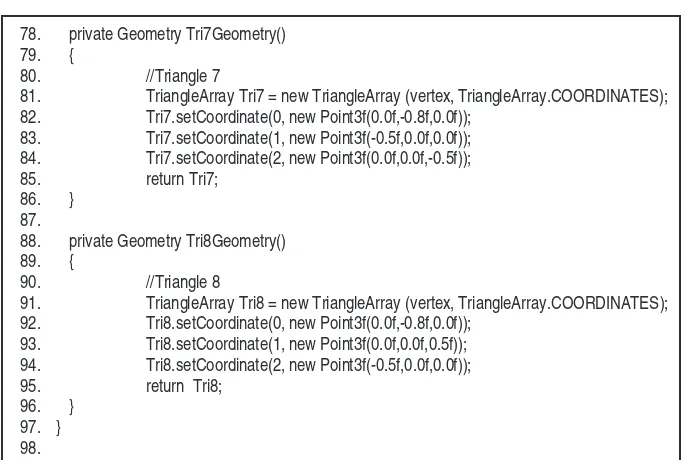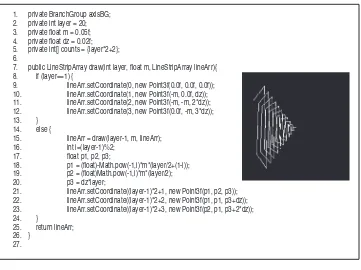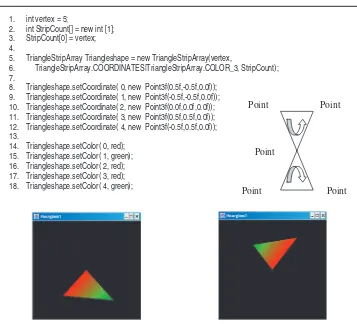I N FORM AT I ON SCI EN CE REFEREN CE
Interactive Web-Based
Virtual Reality with
Java 3D
Chi Chung Ko
National University of Singapore, Singapore
Chang Dong Cheng
Director of Editorial Content: Kristin Klinger Managing Development Editor: Kristin Roth Senior Managing Editor: Jennifer Neidig Managing Editor: Jamie Snavely Assistant Managing Editor: Carole Coulson
Copy Editor: Larissa Vinci
Typesetter: Amanda Appicello
Cover Design: Lisa Tosheff
Printed at: Yurchak Printing Inc. Published in the United States of America by
Information Science Reference (an imprint of IGI Global) 701 E. Chocolate Avenue, Suite 200
Hershey PA 17033 Tel: 717-533-8845 Fax: 717-533-8661 E-mail: [email protected]
Web site: http://www.igi-global.com/reference and in the United Kingdom by
Information Science Reference (an imprint of IGI Global) 3 Henrietta Street
Covent Garden London WC2E 8LU Tel: 44 20 7240 0856 Fax: 44 20 7379 0609
Web site: http://www.eurospanbookstore.com
Copyright © 2009 by IGI Global. All rights reserved. No part of this publication may be reproduced, stored or distributed in any form or by any means, electronic or mechanical, including photocopying, without written permission from the publisher.
Product or company names used in this set are for identification purposes only. Inclusion of the names of the products or companies does not indicate a claim of ownership by IGI Global of the trademark or registered trademark.
Library of Congress Cataloging-in-Publication Data Ko, Chi Chung.
Interactive web-based virtual reality with Java 3D / by Chi Chung Ko and Chang Dong Cheng. p. cm.
Includes bibliographical references and index.
Summary: “This book provides both advanced and novice programmers with comprehensive, detailed coverage of all of the important issues in Java 3D”--Provided by publisher.
ISBN 978-1-59904-789-8 (hardcover) -- ISBN 978-1-59904-791-1 (ebook)
1. Java3D. 2. Java (Computer program language) 3. Computer graphics. 4. Three-dimensional display systems. 5. Virtual reality. I. Cheng, Chang Dong. II. Title.
QA76.73.J38K595 2008 006.8--dc22
200800910 British Cataloguing in Publication Data
A Cataloguing in Publication record for this book is available from the British Library.
All work contributed to this encyclopedia set is new, previously-unpublished material. The views expressed in this encyclopedia set are those of the authors, but not necessarily of the publisher.
Preface ... ix
Chapter I
Virtual Reality and Java 3D ... 1
Introduction ...
1
Interactive 3D Computer Graphics ...
1
Virtual Reality ...
3
Web-Based Virtual Reality ...
5
VRML ...
6
Java 3D ...
8
Mixed Reality ...
10
Summary ...
11
References ...
12
Chapter II
Java 3D Overview ... 18
Introduction ...
18
Getting Started ...
19
A Simple Java 3D Program for a RotatingCube ...
20
Scene Graph Basics ...
22
Scene Graph for the RotatingCube ...
24
View Branch for the RotatingCube ...
25
Content Branch for the RotatingCube ...
26
Branch Group ...
27
Transform Group ...
28
Simple Universe ...
28
Difference Between Java 3D Applet and Application ...
29
Summary ...
30
Chapter III
Geometry Objects ... 32
Introduction ...
32
Shape3D ...
32
GeometryArray Class ...
35
GeometryStripArray ...
43
IndexedGeometryArray ...
56
IndexedStripArray ...
63
Creating an Object Using Multiple Geometry Classes ...
69
Utility Class ...
71
Summary ...
72
References ...
73
Chapter IV
Appearance Objects ... 75
Introduction ...
75
Texture Coordinates ...
99
Texture Properties ...
100
Texture Attributes ...
101
Texture Coordinate Generation ...
103
Multilevel Texturing ...
106
MultiTexture ...
106
Texture in Applets ...
110
Summary ...
112
References ...
112
Chapter VI
Lighting, Fog, and Background ...114
Introduction ...
114
Material ...
115
Ambient Light ...
117
Directional Light ...
118
Spot Light or Cone Light...
122
Light Scopes ...
122
Fog ...
124
Background ...
128
Summary ...
130
References ...
130
Chapter VII
Animation Objects ... 132
Introduction ...
132
Behavior and Animation ...
133
Alpha Object ...
133
Interpolator Object ...
134
PositionInterpolator ...
135
Level of Detail (LOD) ...
153
Morph ...
155
Behavior Class ...
160
Bounding Region ...
163
Wakeup Condition and Criterion ...
165
Keyboard and Mouse Events ...
168
Posted Events ...
169
Collision Events ...
176
Elapsed Time and Frame Events ...
176
Events due to Changes in Positions and Transforms ...
180
Platform Entry and Exit Events ...
183
Sensor Entry and Exit Events ...
185
Combining Different Wakeup Criteria ...
185
Summary ...
186
Chapter IX
Picking ... 188
Introduction ...
188
PickRotateBehavior, PickTranslateBehavior, and PickZoomBehavior ...
189
Picking Classes in General ...
189
Customizing Picking Behavior Class ...
193
PickTool ...
194
Point and Ray Picking Shape ...
195
Ray Segment Picking Shape ...
196
Cone Picking Shape ...
201
Cylinder Picking Shape ...
206
Picking Objects within a Specified Bound from a Certain Position
...
209
Picking in a Virtual Instrument Panel...
212
Summary ...
215
References ...
215
Chapter X
Navigation, Input Devices, and Collision ... 217
Introduction ...
217
Keyboard Navigation Using KeyBoardBehavior ...
218
User Defined Keyboard Navigation
...
219
Navigation Using Mouse Utility Class ...
223
User-Defined Mouse Navigation
...
227
Input Device ...
229
Sensors ...
232
Collisions ...
234
Summary ...
236
References ...
237
Chapter XI
Multiple Views ... 238
Introduction ...
238
View Model ...
239
Single View ...
240
Multiple Views ...
243
View Attach Policy and Activation Radius ...
245
Projection Policy ...
246
Clip Distance ...
248
Window Eyepoint Policy and Field of View ...
248
Conventional Camera-Based View ...
249
Visibility, Screen Scale, Window Movement, and Frame Cycle Time ...
252
Canvas3D ...
252
PhysicalBody and PhysicalEnvironment ...
258
Example Applications ...
260
Summary ...
263
Chapter XII
Audio ... 264
Introduction ...
264
BackgroundSound ...
265
PointSound ...
266
ConeSound ...
268
Aural Environment ...
269
Summary ...
273
References ...
275
Chapter XIII
A Web-Based 3D Real Time Oscilloscope Experiment ... 276
Introduction ...
276
System Reference Model and Working Principle ...
279
Scene Graph and Main Applet ...
279
Control Buttons, Sliders, Knobs, and Other Objects ...
282
Custom Behavior ...
283
Navigation Behavior ...
284
Collision Detection Behavior ...
285
Picking Behavior ...
286
Summary ...
288
References ...
288
Appendix A
Downloading Software ... 290
Appendix B
Running the Rotating Cube Program ... 295
Appendix C
ViewManager ... 301
Appendix D
Main Applet for Web-Based 3D Experiment ... 308
Appendix E
Scene Graph Implementation for Web-Based 3D Experiment ... 322
Appendix F
Knob Class for Web-Based 3D Experiment ... 350
Appendix G
Navigation and Collision Detection for Web-Based 3D Experiment ... 355
Appendix I
Program Summary and Screen Capture ... 441
About the Authors ... 469
Preface
With the emergence of the Java 3D API, the creation of high quality 3D animated graphics
for Java applications and applets has become a possibility. Being a high-level API based
on OpenGL and DirectX, Java 3D allows developers to produce object-oriented graphics
applications that are platform-independent. Numerous applications in fields ranging from
business, science, medical to education have been implemented based on this technology.
One well known example is the Maestro project, which allows users to navigate the 3D
world of Mars from a desktop computer based on inputs from eight 360-degree cameras
onboard the rover.
In one of our research projects in this area, we have used Java 3D to develop a Web-based
real time 3D oscilloscope experimentation system, which has been launched at National
University of Singapore. This application enables users to carry out a physical electronic
experiment that involves the use of an actual oscilloscope, a signal generator, and a circuit
board remotely through the Internet. Specifically, the control of the various instruments are
carried out in real time through the use of a Java 3D based interface on the client side, with
the results of the experiment being also reflected or displayed appropriately on 3D instru
-ments in the same interface.
Apart from the room and instrument geometry, three important and difficult issues that have
been tackled are navigating behavior, collision detection and picking behavior. Specifically,
navigating behavior controls how the user is able to walk around in the virtual laboratory
as well as the positions and angles of the view platform, as when the user attempts to get
a better view. The use of appropriate collision detection ensures that the user is not able to
traverse any solid objects such as walls, tables and instruments, while a customized picking
behavior is necessary for the user to adjust the controls on the instruments precisely.
To satisfy these requirements and noting that the users will not be familiar with the use
of special keys for 3D navigation, a more sophisticated and customized navigating system
has been designed and developed. In this system, navigation can be done by using either
the mouse or the keyboard. Specifically, the position and direction of the view platform or
viewpoint can be changed by simply using the mouse to press two specially designed groups
of control objects, a navigating speed slider, a translation, and a rotation icon.
To change the user’s “walking” speed through the 3D virtual laboratory, the navigating
speed slider can be adjusted. This will change the delays used in the main processing steps of
the navigating function. An icon with six straight arrows allows the user to move in a straight
translational manner. Pressing a ball in the center of the icon will reset the viewpoint to its
initial position. The other icon with four curved arrows allows the user to rotate around the
current position. The ball in the center will reset the viewpoint to a horizontal one.
With 3D scene-based navigation and manipulation implemented, the system is able to
provide a more realistic 3D feel to users who are conducting real-time Web-based
experi-mentations. In the course of designing and developing this application, a large number of
Java 3D example and program codes has been written, and an API library for the creation
of similar Web-based 3D experiments has been developed. Specifically, the library includes
a series of code segments and classes for defining the geometry and appearance of control
buttons, knobs, sliders, clips and scope displays as well as their behavior in a 3D world.
This has culminated in the writing of this book, which aims to provide programmers
with a simple but yet complete, comprehensive, and detailed coverage of all the important
topics in Java 3D.
In particular, this book includes a large number of programming examples for the reader
to master this graphics API to develop sophisticated Java 3D graphic programs. Specifically,
the use and significance of keywords, syntax, classes, methods, and features that make up
the API are illustrated with 300 figures, 200 code fragments, and 100 examples throughout
the 450 pages of the book to provide an easy-to-read and easy-to-use learning experience.
All of the important Java 3D topics, including geometry, appearance, navigation,
pick-ing, animation, interaction, texture, light, background, fog, shade, input device, sound, and
advanced view will be covered. Both novice and advanced graphics programmers, including
those who know Java but do not have any background in computer graphics, will find the
book useful from the large number of working examples provided. In addition, each chapter
is written in a relatively independent manner so that readers with specific interests can make
In total, the book consists of 13 chapters covering the various topics, and is organized
in a step-by-step style. Discussions on basic 3D graphics, Java 3D overview, 3D geometry,
appearance, texturing, animation, and interaction are discussed in the first six chapters.
Subsequently, more advanced topics on navigating, picking, input device and are explored.
The use of more complicated multiple views and audio are then discussed, culminating in
the last chapter, which presents the Web-based 3D experiment application in detail. The
following gives a brief synopsis on each of the chapters.
Chapter I provides an overview of interactive 3D graphics, OpenGL, virtual reality,
VRML, Java 3D and mixed reality. The main purpose is to give an outline on the
relation-ship between these related technologies and applications. This also serves to place Java
3D in the appropriate context from the general perspective of 3D graphics creation and
presentation.
Although many programming languages are available for creating 3D graphical
applica-tions, only Java 3D, VRML and the subsequently developed X3D are suitable for Web-based
virtual reality development. As a result, while other tools are also briefly introduced, this
chapter will discuss, analyze and compare VRML and Java 3D in detail. Subsequent chapters
in this book will focus on various aspects of Java 3D with an aim to provide a comprehensive
experience in terms of understanding and programming using Java 3D technology.
From the discussions in this chapter, the differences between VRML and Java 3D will
be better appreciated. It will be pointed out that, as one of the two important development
tools for Web-based virtual reality, Java 3D has established itself as an important
model-ing and rendermodel-ing languages for more specialized applications that involve, for example,
database accesses, customized behaviors and home use mobile devices such as PDA, mobile
phone, and pocket PC.
Chapter II is a relatively short chapter laying the ground work for the creation of a
virtual world in Java 3D. This chapter introduces the programming paradigm or the scene
graph approach. Specifically, after providing some basic knowledge on VirtualUniverse,
SimpleUniverse, Locale, BranchGroup, and TransformGroup objects, which form the
virtual world framework, this chapter outlines how one can build a virtual world through
specifying a scene graph.
The scene graph in Java 3D is for the purpose of describing the objects in a virtual 3D
world, and is a tree like structure consisting of a hierarchy of nodes containing information
on objects or groups of objects on geometries, shapes, lights, sounds, interactions, and so
on. Specifically, the root of the scene graph is a virtual universe that may have several local
branches. Also, each locale may hold related objects that are next to one another at a certain
location in the 3D world, and may be made up of many branch and transform groups.
Each branch group is a subgraph of the scene graph, and can be compiled for rendering
efficiency. Also, by setting certain capabilities, branch groups can be attached or removed for
carried out easily by invoking a simple universe. Alternatively, multiple views of the same
virtual world can be obtained for applications involving multiple displays.
Chapter III focuses on creating shapes and 3D objects that can be rendered by Java 3D
using both core and utility classes. Different approaches to object creation will be explored,
helping programmers to construct complex shapes using simple building blocks.
In this chapter, several basic geometry classes that can be used to specify the geometry of
visual objects in Java 3D will be introduced and discussed. Specifically, PointArray, LineAr
-ray, TriangleAr-ray, and QuadArray are useful for building objects using a series of points,
lines, triangles and quadrilaterals, while for structures where the series of lines or triangles
are adjacent to each other in a certain manner, the use of LineStripArray, TriangleStripArray,
and TriangleFanArray may be more convenient and lead to faster rendering.
The problem of requiring certain vertices to be repeated when these basic classes are used
can be overcome through using their indexed versions, where the sequence of vertices can
be supplied via some integer indexing arrays. Complex objects can also be created through
appropriately combining objects built from different classes. Also, simple geometrical shapes
such as boxes, spheres, cones or cylinders can be easily generated using some predefined
utility classes in Java 3D.
In Chapter IV, the appearance of the created 3D objects is discussed, including some
parameters that control how they will be presented to the user. Important appearance attributes
are illustrated by using examples so that the effected changes can be better appreciated.
For most virtual reality or game applications, point, line and polygon are the basic
primitives for constructing objects in the 3D world. The chapter therefore gives an in depth
account of the various basic attribute settings, including rendering modes, visibilities, colors
and material properties, that can be applied to these primitives.
Although extensive use of basic attributes such as color and material will be able to
make an object realistic to the human user, the amount of programming codes needed will
in general be very lengthy and time consuming to develop if the object has complicated
geometry or appearance. As an example, to create an object with many color patterns on,
say, a curve surface, many zones or strips may need to be individually defined using the
appropriate color or material properties. Since this is time consuming, Java 3D allows the
use of what is known as texturing and image mapping, which will be discussed in the next
chapter.
Building on Chapter IV, Chapter V describes the technique of texture mapping to add
realism to virtual scenes. The use of texture modes and attributes in Java 3D, which is
relatively straightforward and effective for adding color and realistic details to the surface
of a visual object, will be presented to give programmers a reasonable palette of texturing
techniques with which to work on.
Specifically, texture objects are referenced by appearance objects, and have a variety of
out through the TexCoordGeneration class. The application of multiple textures to a surface
can give a very realistic visual effect on the visual objects created in the virtual universe.
Chapter VI explores other issues that lead to better environmental realism. These
includ-ing lightinclud-ing, fog, and background that can be used to further enhance the appearance of the
virtual world. In general, these environmental factors affect the appearance of the object
through their interaction with its material attribute.
Specifically, the use of ambient, directional, point and spot lights will be presented.
Topics involving material and normal settings, which determine how light will be reflected,
will also be discussed. Some examples on the use of linear and exponential fog to smooth
a scene and to prevent the sudden appearance of distant objects so as to enhance its
emo-tional appearance will be given. Then, the use of simple color, image, and geometry based
backgrounds will be illustrated.
Chapter VII discusses the use of interpolators and alpha classes for object animation
in the virtual world. Simple animated movements such as rotation, translation and their
combinations will be covered. More advanced animation techniques such as scaling,
trans-parency, and morphing will also be discussed. In addition, The billboard and the level of
detail (LOD) classes, which are useful for creating animation at a reduced rendering level,
will be presented.
The various animation classes provided by Java3D are usually quite complete in terms
of their functionality. Very often, just a few parameters will be sufficient to implement a
variety of simple and basic animation in Web-base virtual reality applications. For more
complex scenarios, these classes can be further defined with more specific codes to give
rise to more complicated movements.
The movements of objects in a 3D world are very often the result of the user
manipulat-ing these objects or just navigation through them. As an example, the animation that allows
a 3D clock hand to turn may need to be re-initiated if the user presses a certain reset button
in the 3D world. The issue of interactions is therefore closely related to animation and is
the main concern of the next chapter.
To detect and deal with interactions from the user, Chapter VIII delves into some basic
issues on event detection and processing. These include capturing the key pressed, mouse
movement, finding changes in the state of the virtual object and time lapsed. In Java 3D, the
detection of these events or detection conditions are based on examination of the appropriate
components of the behavior class of an object.
Specifically, to specify and implement an interaction, it is necessary to make use of
some special behaviors and events that Java 3D provides or to refine or customize these
After giving a basic foundation of event detection and processing, the next two chapters
provide a more advanced coverage of the topic in two important interaction scenarios. These
correspond to the picking of objects and use navigation in the 3D world.
Chapter IX discusses the use of the picking behavior class for the purpose of picking
objects of interest. Using simple utility classes such as PickRotationBehavior,
PickTrans-lateBehavior, and PickZoomBehavior is straightforward, although the picking behavior may
not be flexible enough for most applications.
In general, the simple operation of picking an object in the real world is actually very
complicated and involves many senses. To allow the user to pick objects in the virtual 3D
world as realistically as possible, Java 3D has a variety of picking shapes, such as PickRay,
PickConeRay PickCylinder and PickBounds, that can be used to customize the picking
behavior. After discussing these in some detail in this chapter, an application example
involving the use of the controls in a 3D instrument panel will be provided.
Chapter X is on another important interaction behavior, that for the user to navigate or
move in the virtual world. At the beginning of this chapter, the basic navigation classes
provided by Java 3D are introduced. Due to the fact that they are not very flexible, these
classes cannot be used for navigating in most virtual reality applications.
As a result, there is a need to make use of Java 3D utility classes as well as more
special-ized user-defined behavior classes for designing customspecial-ized navigation behavior in many
virtual reality applications. This chapter will discuss how rotation and translation matrices
can be used for calculating the position and orientation of the objects as the viewpoint
changes. The use of navigation tools for moving and turning with the help of keyboard,
mouse, joystick, and other external devices will also be presented. In addition, another
important issue, that involves the collisions of objects and how these can be handled, will
be discussed in this chapter.
In Chapter XI, some advanced topics needed for generating multiple views of the virtual
universe in Java 3D will be discussed. Illustrated with examples on configuring the viewing
window to the virtual world, one will be able to see the virtual world from different
per-spectives, resulting in customizing viewpoints. Real life applications such as portal view in
immersive virtual reality environment and video wall configuration will be introduced.
In Chapter XII, how 3D sound sources and aural characteristics can be integrated into
the virtual world built using Java 3D will be outlined. Java 3D supports three types of sound
sources, BackgroundSound, PointSound, and ConeSound, which will become audible if the
activation radius intersects with the scheduling bounds of the sound. Controls can also be
made available to turn a sound source on or off, set its gain, release style, continuous playback
style, looping, priority, and scheduling bounds. In addition, by creating a SoundScape object
with appropriate AuralAttributes, a special acoustical environment can be simulated.
We are particularly thankful to Prof. Ben M. Chen, Dr. Xiang Xu, and Dr Lu Shijian for
their kind help and assistance. We are also thankful to Ye Jiunn Yee, Yupinto Ngadiman,
Nguyen Trung Chinh, Henky Jatmiko Gunawan, Ang Wee Ngee, Au Heng Cheong, Teo
Sing Miang, Lee Chi Shan, Tam Sai Cheong, Thian Boon Sim, Subramanian S/O Annamalai,
Cheong Yew Nam, Ho Chang Sheng Herman, Wu Sin Wah, Ng Chea Siang, Lim Tiong
Ming, and Thulasy Suppiah, for their help and contribution in the testing and debugging of
the various source codes. Last, but certainly not least, we would like to acknowledge the
National University of Singapore and the Singapore Advanced Research and Education
Network for providing us with research funds that lead to this book.
Chapter I
Virtual Reality and
Java 3D
INTRODUCTION
Web-based virtual reality is fast becoming an important application and technological tools
in the next generation of games and simulation as well as scientific research, visualization,
and multi-user collaboration. While tools based on VRML (virtual reality modeling
lan-guage) are frequently used for creating Web-based 3D applications, Java 3D has established
itself as an important modeling and rendering languages for more specialized applications
that involve, for example, database accesses, customized behaviors, and home use mobile
devices such as the PDA, mobile phone, and pocket PC (Kameyama, Kato, Fujimoto, &
Negishi, 2003).
Before discussing Java 3D is more detail, we will first give an overview of related
topics on interactive 3D computer graphics, virtual reality, and Web-based virtual
real-ity in this chapter. Specifically, a very brief introduction to VRML and OpenGL will be
provided, including some comparisons of these tools with Java 3D. We will then embark
on our journey on Java 3D by giving an overview of Java 3D through the use of a simple
programming example.
INTERACTIVE 3D COMPUTER GRAPHICS
In general, the field of computer graphics includes the creation, collection, processing,
(Rhyne, 1997). Very often, this is supplemented by the need for an interactive graphical
user interface that captures user inputs through appropriate mouse, window, and widget
functions. In terms of applications, computer graphics is an important subject in digital
media technologies, scientific visualization, virtual reality, arts, and entertainment.
The basic theory for computer graphics can be found in the references by Pokorny
(1994), Hearn and Baker (2006), and Foley, Dam, Feiner, and Hughes (2006). Very simply,
in 3D computer graphic application, the components in a particular scene are often defined
by using mathematical relationships or geometries. Specifically, these involve the use of
graphical primitives that correspond to basic geometrical shapes for constructing graphical
scenes. Each primitive may have many attributes including size and color.
To create 2D graphics, primitives such as line, circle, ellipse, arc, text, polygon, and
spline are frequently used. For more complicated 3D applications, the primitives employed
may include cylinder, sphere, cube, and cone. The main purpose of using these
primitive-based representations is to speed up rendering in real-time. This is especially important
in scenarios involving a large scale virtual world.
Since most display devices are 2D in nature, the projection or transformation of a 3D
world on a 2D screen is an inherent process in most applications. This is not a trivial task,
especially when there is a need to create immersive 3D effect by using lighting, volume,
and shadowing techniques.
While the use of static 3D graphical primitives may satisfies the requirements in
some cases, the ability for the user to interact with virtual or real objects in a 3D world
are needed in a lot more applications. As examples, interactive 3D graphics can provide
us with the capability to interact with movable objects or scenes, for exploring complex
structures, and to better visualize time varying phenomena and architecture design. In
general, with realistic interaction included in a 3D world, we arrive at what is commonly
known as virtual reality.
To create 3D computer graphical applications, a variety of programming tools may be
needed depending on the type of applications and hardware support available. A commonly
Figure 1. OpenGL rendering pipeline
Unpack Pixels
Image OperationPixel RasterizationImage
Unpack Vertices
Geometry OperationVertex RasterizationGeometric
used programming tool, very often provided in the form of graphical libraries, is OpenGL
(open graphics library). OpenGL is in turns based on GL (Graphics Library) from SGI.
OpenGL has grown to be an industrial standard library for graphical application
devel-opment, and consists of a set of procedures and functions that allow the programmer to
specify objects and operations associated with producing high quality computer graphics.
Figure 1 illustrates the rendering pipeline used in OpenGL.
An introduction to computer graphics and OpenGL programming, including some
advanced topics such as Web3D, virtual reality, interconnection, and file formats, can be
found in Chen (2003) and Chen (2006). A general introduction to OpenGL can also be
obtained from the books written by Angle (2003) and Woo, Neider, and Davis (2006).
Another important tool that can be used for 3D graphics programming is DirectX, which
is a set of graphical libraries developed by Microsoft. Obviously, DirectX is targeted for
Microsoft Windows platform and is therefore not as platform-independent as OpenGL.
For the purpose of Web-based applications, which may involve different machines and
platforms, OpenGL is a more suitable choice for program development. Figure 2 shows
how OpenGL can be used for both native 3D graphics programming (with C/C++) as well
as Web-based 3D programming (with Java3D). The latter is the main focus of this book
and will be discussed in details subsequently.
VIRTUAL REALITY
Virtual reality has been defined by Hamit (1993) as “the presence of human in a computer
generated space,” or more specifically, “a highly interactive, computer-based, multimedia
Figure 2. OpenGL in 3D graphics programming
OpenGL DirectX
Java3D Java
Abstraction API
Graphics API Programming Tool
Device Hardware
environment in which the user becomes a participant with the computer in a virtually real
world.”
Emphasizing the interaction and interface aspects, Stone in 1995 regarded virtual reality
as an “interface between human and computerized applications based on real-time,
three-dimensioned graphical worlds”. Most VR systems therefore try as much as possible to provide
users with the capability to interact with the system in the same way as their interaction
with objects and events in the real world. Essentially, the basic objective is to provide a
shared 3-D experience between people and computer with certain unique capabilities that
allows the user to experience an artificially generated environment as if it is real.
To extend the impact of realistic visualization and experience, Isdale in 1995 defined
virtual reality as “a way for humans to visualize, manipulate and interact with computers
and extremely complex data”. Such visualization is not limited to just graphics, but may
also takes on a more general form of visual, auditory or other sensual outputs to the user.
According to these definitions, a virtual reality application has the following inherent
important features.
•
Interactive:
Realistic interactions with virtual objects via data gloves and similar
devices to support the manipulation, operation, and control of objects in a virtual
world.
•
Real time:
Viewing, interactions, and other related tasks have to be executed with
real-time response so that the resulting illusion of being fully immersed in an artificial
world is as convincing as possible.
•
Immersive:
Head-referenced viewing can be taken as an example to provide a natural
interface for navigation in a 3D space, and can give the user the ability to look-around,
walk-around, and fly-through in the virtual environment. Sound, haptic devices, and
other non-visual technologies can also be used to enhance the virtual experience
significantly.
The creation of a realistic virtual 3D world is a long term goal in interactive computer
graphics, requiring hardware and software systems that have yet to be constructed.
Spe-cifically, real-time rendering at the rate of at least 20fps very often requires significant
computational power.
Since the rendering speed is a function of the number of polygons for the entire model in
the application, this is a critical performance or complexity factor as a PC may only be able
to render tens of thousands of polygons in real-time. In large scale applications involving
complex models with up to a million polygons, powerful computer systems with special
graphics hardware are often needed. This may be a major consideration in the deployment
of virtual reality systems.
Unlike passive holographic or stereoscopic 3D video, virtual reality is inherently an
virtual reality, while initially focused on immersive viewing via expensive equipment,
is rapidly expanding and includes a growing variety of systems for interacting with 3D
computer models in real-time.
From an immersive graphical point of view, virtual reality can also be classified as
follows.
•
Full-immersive 3D graphic:
Full immersive systems include full scale
representa-tion, stereoscopic viewing, and head-referenced navigation. The term virtual
real-ity initially referred to these systems. Head-mounted display (HMD) is currently
commercially available for providing users with a certain level of immersive virtual
reality experience.
•
Semi-immersive 3D graphic:
Semi-immersive systems include large screen
projec-tions with or without stereo or table projection systems.
•
Non-immersive 3D graphic:
Non-immersive systems only have monitor-based
viewing of 3D objects. This is the simplest way to display a virtual reality world
through the use of appropriate projection. Most Web-based virtual reality systems
are currently used on the use of non-immersive technology due to hardware, cost,
and bandwidth constraints.
As applications of virtual reality, virtual world or virtual environment (VE) is often used
to refer to the use of 3D graphics, 3D sound, and real-time interaction in an environmental
simulation. Specifically, a VE is an environment, which is partially or totally based on user
or computer generated sensory input, which may include information from the three most
important senses of sight, hearing, and touch.
WEB-BASED VIRTUAL REALITY
The rapid development of the World Wide Web in recent decades has created an important
variant of virtual reality applications, that of Web-based virtual reality. Applications in this
domain are usually developed using the main programming languages of virtual reality
modeling language (VRML) as well as the 3D API extension of the Java language. The
former is a specification obtained from an extended subset of the SGI Open Inventor scene
description language, which is a higher level programming tool for OpenGL.
Figure 3 presents the relationship between VRML and Java 3D. As shown, a 3D
Web-based application will have programming codes in Java or Java3D in general. Some of
these codes would invoke the Java3D API, which will in turn invoke lower level routines
in libraries such as DirectX or OpenGL.
is associated with the 3D application must therefore be embedded into a 2D browser such
as Netscape or Microsoft Internet Explorer.
Using a plug-in browser, the user can explore a virtual 3D world, zooming in and
out, moving around and interacting with the virtual environment. With VRML, standard
navigational tools like walk-trough or fly-over are provided by using the relevant plug-in.
On the other hand, when a Java 3D plug-in is used, there is a need for the programmer to
design and supply a more customized set of navigation tools to the user. In general, this
requires more programming efforts, but will be able to provide a more flexible, realistic
and professional interface to the user. As an example, it may allow the user to navigate
through a 3D world model in an arbitrary way or along a predefined path by using, say,
just the mouse.
Both VRML and Java 3D allow fairly complex 3D graphics to be transmitted across
networks without the very high bandwidth capacity that would be necessary if the files were
transmitted as standard graphic files. In general, the information transmitted may include
platform-independent multimedia elements, such as texture images, video, and sounds.
VRML
Before discussing Java 3D in detail in this book, we will now give an outline of VRML in
this section and discuss its relationship with Java 3D in subsequent sections.
VRML is a specification for producing 3D interactive worlds on the Web, and is the
original and most popular form of Web3D. As a 3D scene description language and file
format, VRML allows encoding and encapsulation of 3D content on the Internet. As given
below, it has undergone a long history of evolving from versions 1.0 to X3D.
Figure 3. Relationship of VRML and Java 3D
OpenGL
DirectX
Java3D
VRML
Mid-level
Low-level High-level


